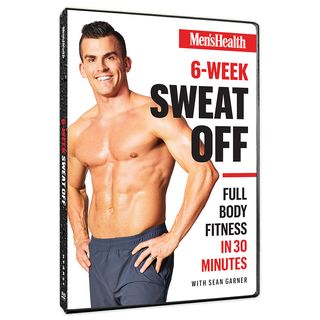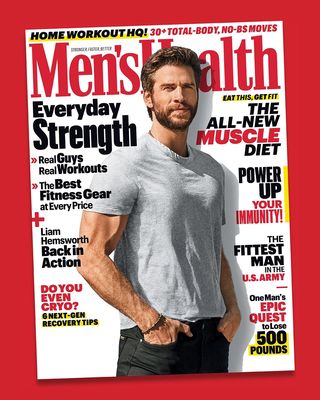When you find out just how simple it is to get lean and see your abs, you’ll be amazed that more people aren’t willing to put in the work to get ripped. Case in point: Sean Garner.

Men’s Health
The Miami-based trainer had two kids and a third on the way when Men’s Health tapped him to create the 6-Week Sweat Off body transformation program for the All Out Studio fitness platform. “I had been letting life and work take priority,” he says, “and I let myself go a little bit.”
Following the same program he designed for busy guys like you got him the results you see on this page—down three pounds, and under eight percent body fat—in just six weeks.
Garner’s program can be condensed into the following five-point plan that just about anybody can follow.
1. Train With Tri-Sets
The 6-Week Sweat Off program consists of workouts that last only 30 minutes and require only a set of dumbbells, so that’s what Garner limited himself to (he used Powerblock weights that ranged from five to 90 pounds). He trained five to six days per week on a three days on, one off split: upper body, lower body, full body, then a rest day, and repeat.
Garner organized each workouts exercises into tri-sets—three moves grouped together and done back to back. The first tri-set of a full-body workout could be a floor press, single-leg deadlift, and plank. Garner would perform each move for 40 seconds, doing as many reps as he could in that time (the plank, of course, is held for time), and then rest 20 seconds between exercises. He repeated that for three total rounds, resting up to 60 seconds between rounds. Then he’d move on and do two more tri-sets in the same fashion—for example, a dumbbell row, lunge, and overhead press, and then a hammer curl, alternating bear row, and skull crusher.
“The full-body workouts emphasize cardio,” says Garner, “because you’re working so much muscle mass in a short time. The upper and lower days allow you to hammer specific muscles a little more,” so you get conditioning and strength in the same program. On days he didn’t lift, Garner took hour-long walks, and that was all the extra cardio he needed.
2. Eat More Protein and Vegetables
Garner aimed to eat 1.5 grams of protein per pound of his body weight every day, and as many vegetables as he could. (He weighed 195 pounds at the start of the six weeks, and averaged 280 grams of protein daily.) This helped him support muscle growth while keeping hunger under control. Since protein and fiber are highly satiating nutrients, he didn’t have to worry about counting calories or overeating.
“If you don’t plan out what you’re going to eat, you’ll have those moments where you panic when you’re hungry,” says Garner, “and you’ll end up grabbing anything you can find. To avoid that, I would get Amazon to deliver chicken, fish, and vegetables, and then I’d grill the meat and chop the veggies and put them all in Ziploc containers.” The process of making all his meals for the week took about 90 minutes on Sunday afternoons.
Breakfast was typically a five-egg omelet with tomatoes, onions, and bell peppers. Lunch was a salad with chicken, fish, or ground turkey on top, dressed with salsa or olive oil and balsamic vinegar. In the afternoon, Garner would have a protein shake and a handful of nuts. Dinner was another lean meat with vegetables. When he had cravings for something sweet, Garner froze some berries in a low-sugar, coconut-flavored whipped topping. “It tastes like ice cream,” he says.
3. Work Out in the Morning
Garner has to be up by 6:30 a.m. to get his daughter to school, so he wakes up at 4:30 a.m. to do his workout and eat a meal beforehand. “I usually recommend that people work out first thing in the morning if they can,” he says. “It gives you energy for the day, and then it’s done. If you put it off till later, odds are you won’t do it at all.”
If you prefer to train later in the day because you’ve hurt yourself in past morning workouts, consider that it was probably due to not warming up properly. However, it’s true that the spine is also less stable in the morning, because it decompresses while you’re sleeping. Exercises like barbell squats and deadlifts, in particular, are best done in the afternoon, when the body is warmed up and the spine has stiffened a bit from walking around. “But my program uses only joint-friendly exercises,” says Garner, so there’s little risk of you getting hurt if you have to do them shortly after rising (note: you should still warm up anyway for maximum safety, but there’s nothing in the Six-Week Sweat Off that’s inherently risky).
4. Weigh In
Garner weighed himself every morning—after he used the bathroom, and before eating. “What you measure, you change,” he says. However, he didn’t get hung up on the numbers he saw, and you shouldn’t either. “There will always be day to day fluctuations in weight due to water retention,” says Garner, so don’t freak out and think you’re gaining weight if you suddenly find yourself up two pounds.
Weighing daily helps you see how you’re trending over time. If your average weight in Week 2 is one pound less than it was in Week 1, you know you’re on the right track. “If you’re losing even a half-pound per week, that’s awesome,” says Garner. Gradual weight loss is sustainable, and ensures that you don’t lose muscle. Garner only lost three pounds during the program, but he held onto his muscle (and possibly gained some), resulting in a significant body re-composition.
5. Sleep Like A Baby
“One of the biggest change-makers for your body, although it isn’t sexy, is sleep,” says Garner. “That was my top priority over the six weeks.” He wore a WHOOP fitness tracker and aimed for a 100 percent sleep score every night. “I would try to be in bed by 8:30, and sleep nine or 10 hours.” If he couldn’t go to bed early because he was out, or helping his kids with their homework, he would sleep in the next morning, or skip training that day. “People are overstressed as it is,” says Garner, “and when you work out, you just create more stress,” so training when you’re already run down can make things even worse.
“When you prioritize sleep, you recover better and are then able to push yourself much harder when you train,” says Garner. “That’s how you make a 30-minute workout effective. It won’t be effective if you’re too fatigued to push yourself.”
Bonus Tip: Have A Vision
“Starting with the end in mind helps you stick to the habits that eventually get you there,” says Garner, who often asks clients to find a picture of someone who has the kind of physique they want, and save it on their phones, so they can refer back to it.

Men’s Health
GET THE WORKOUT HERE
Garner’s own motivation was a picture of himself that had yet to be taken. He visualized how he wanted to look modeling the 6-Week Sweat Off workouts and cover shots. “Having the opportunity to represent the world’s best fitness brand made me make sure to give it my best,” says Garner. “I knew I wanted to be in my best possible shape, the leanest I could be, and that drove me.”
You don’t have to release your own top-selling fitness product to look like the guy on the cover of one—but keeping your ideal body in your mind’s eye can play a role in getting you there.

Source: Read Full Article
